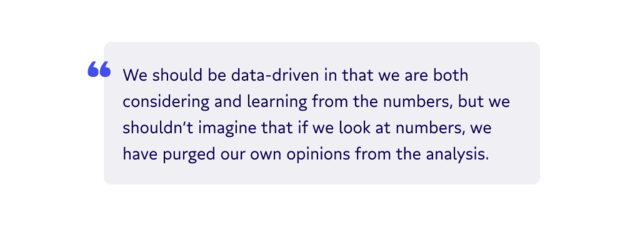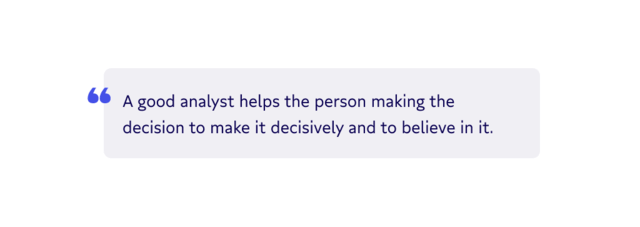Data professionals are really data scientists; our decisions are grounded in logic, not emotion. After all, numbers don’t lie.
Or do they?
And if they do – does it really matter? 🤔
Census co-founder and CEO Boris Jabes tackled some of these uncomfortable philosophical questions recently with Benn Stancil, founder and chief analytics officer at Mode. Despite our industry’s mass obsession with finding a single source of truth, analysts pursuing pure truth, they decided, is like Don Quixote tilting at windmills (or attacking an imaginary enemy). 🤺
There’s a pervasive sort of magical thinking that data analysts are “true neutral” scientists. That data science simply uncovers universal truths with no particular agenda; that analysts don’t value influencing people as much as they value having the right answer.
“Whether or not they realize it, everyone has an agenda,” Benn said. “Analysts simply pursue their agenda through numbers — we’re still making an argument, just from a different place. In the end, the effectiveness of the argument is still judged by whether or not people are convinced.”
In most cases, there is no real, ground truth. Even a straightforward question like, “How many customers do we have?” has multiple answers depending on alternate definitions. Every way you pull the question apart has assumptions baked into it – and with harder questions come more assumptions.
“There’s some danger in presenting yourself as someone who is just listening to the data, deriving truth from all these numbers,” Benn said. “We should be data-driven in that we are both considering and learning from the numbers, but we shouldn’t imagine that if we look at numbers, we have purged our own opinions from the analysis.”

Finding the right answer is not always right
The mathematical minds that gravitate towards data analysis can become so focused on the precision of their measurements and algorithms that they completely ignore the value of the thing they’re measuring. With no ground truth guiding the analysis, you can spend a lifetime pulling metrics apart to tease out any and every variable without getting better data.
When finding the true answer becomes an end in itself, business outcomes and initiatives suffer. The mission of data team members is to come to an answer that drives action – whether or not it is the objective truth.
“Hesitation in an organization is guaranteed to be really bad in the long run,” Boris said. “We should disabuse people of this notion that anything is ‘right.’ Data’s never ‘true.’ Your job as a data team is not to know the right answer, it’s to remove hesitation.”
Benn compares it to a game between professional and amateur poker players. Both are constantly analyzing the game to decide their next move, but what elevates the professional’s game, and ultimately differentiates the players, is the ability to act on their decisions without hesitation.
“A good analyst helps the person making the decision to make it decisively and to believe in it,” Boris said. “When you’re wrong, learn and adapt. What the exec will remember is the analyst made them a more confident version of themselves. That will do more to convince them they need that analyst than whether the numbers were good.”

There is a tendency in data circles to look down on analysts who stick their necks out and share opinions along with the data. When being right is valued more than having influence, getting ahead in your career by sharing opinions can feel like cheating. But just like every other industry, putting yourself on the line is the most reliable way to get ahead in data.
“The way you lead people is not by being the smartest person in the room, and it’s not by showing people numbers and charts,” Benn said. “It’s awful when analytical people couch everything in hedges and caveats like ‘this suggests’ and ‘the data indicates.’ You can only go so far if your primary goal is not to be wrong, so you need to lead by convincing people through emotions, data storytelling, and other things that most data people see as window dressing.”
Reducing the frequency of “wrong”
If the job of a data analyst is to reduce hesitation and drive action, we all have to get a lot more comfortable with being wrong. Helping decision makers make the right decision every time is impossible, but helping them make the wrong decision less often is a solid goal for a good analyst.
“Fail fast and fail forward” is a common credo of co-founders – and that’s a lesson data teams can take to heart. Embracing that we might be wrong is a bitter pill for data people to swallow, but taking a stand and being confident in your decisions is often the best thing you can do for your stakeholders and executives.
“Everyone benefits when you present your analysis and say, ‘I think we should do this,’” Boris said, and Benn agreed. Ultimately, Benn said, the analyst’s decision-making is going to color the analysis in some way anyhow, so after fairly presenting all options, it is beneficial to offer a dashboard-based recommendation – not brazen.
In particular, leaders may not have a deep enough understanding of the data to apply it and predict future outcomes. By presenting data and sharing their opinions, analysts can provide the context that helps leaders choose the option they feel comfortable with (even if it turns out to be the wrong choice). 🤷♀️
“We will sometimes be wrong and it’s not always because the analysis was wrong,” Boris said. “Sometimes it’s a 51 percent chance versus a 49 percent chance and we choose the wrong one. The best thing you can do for your company is show leadership a cheap option with a low downside.”
Nobody wants to be responsible for making a recommendation that fails, but a company’s success rests on executives’ ability to make confident business decisions quickly. When the data clearly points to a course of action, it’s the analysts’ responsibility to make the benefits of that action clear. The truth isn’t hiding in ever-deeper analysis; it’s found in making decisions and adapting when they’re wrong.
Want to learn more? Listen to the full conversation between Boris and Benn here. Got thoughts and opinions about this topic? Join the conversation around this, and many other data best practices, in ✨ The Operational Analytics Club. ✨


















